Pug (steam locomotive)
'Pug' locomotives are small steam locomotives which were produced for light shunting and industrial work, often on dockyards and factory sites, such as steelworks, collieries, etc. The Pugs are named after a common term in Scotland for a small industrial shunting locomotive – typically an 0-4-0 tank. ‘Pug’ was a dialect word meaning ‘monkey’ inferring an ugly appearance.[1][2] Another suggestion is that the locomotive type is named after the small sturdy 'Pug' dog, an ancient and well known breed with a snub nose, wrinkled face, and squarish body.[3] Many were saddle tanks, with the water tank sitting on top of the boiler like a saddle.
Whilst most commonly used for small shunting engines, on some railways the term 'Pug' was used for all tank engines. For example, the very large Glasgow and South Western Railway 540 Class 4-6-4T express passenger locomotives were known to their enginemen as the 'Big Pugs'.[4]
Examples
Many locomotive manufacturers produced Pug type locomotives[5] mainly for shunting work and for use on industrial sites with tight curves for which 0-6-0 locomotives were less well suited, despite their greater tractive effort capabilities. The Lancashire and Yorkshire Railway L&YR Class 21 were nicknamed 'Pugs' and the Caledonian Railway built a class of 0-4-0 Pugs. The North British Railway had a class of 38 locomotives designated NBR G Class which were commonly nicknamed 'Pugs' by staff.
A typical example is illustrated by the makers plate of number 1821, an 0-4-0 steam locomotive ordered from Andrew Barclay Sons & Co. on 12/02/1924 by the Caprington and Auchlochan Collieries Ltd. The locomotive was delivered to the customer in 1925 and mainly worked at Mauchline Colliery number 7 pit in Ayrshire, before ending its days at the nearby Barony Colliery.
Pugs were used Worldwide, such as the metre gauge Black Hawthorn, an 0-4-0ST locomotive that was imported into India in 1873 for an irrigation project and shunted at Ajmer for several years in the later part of its working life. It can now be seen plinthed outside the Ajmer works.[6]
In fiction
In The Railway Series books by the Reverend W. Awdry, a character called 'Pug' appears in the 12th book, The Eight Famous Engines. After problems of consistent accuracy of the drawings in the early books, later characters were based more closely on real locomotives. Although not explicitly identified by Awdry, the locomotive in the illustration by John T. Kenney,[7] has been identified as most closely resembling a LMS Kitson 0-4-0ST.[8]
Railway modelling

The Hornby model railway manufacturing company have produced a 0-4-0 Caledonian Railway Pug locomotive[9] and Dapol Model railways have produced a LMS branded ex-Lancashire and Yorkshire Pug.[10] This model is now manufactured by Hornby.
References
- LNWR Locomotive classes Archived 2008-12-02 at the Wayback Machine
- Scots Dictionary
- Definition of the word Pug.
- Smith, David L., Locomotives of the Glasgow & South Western Railway, David & Charles, 1976, page 140
- An 1885 Neilson & Co Pug.
- Metre Gauge Pugs
- The Rev. W. Awdry (1957). The Eight Famous Engines. Edmund Ward. p. 53. ISBN 0-7182-0011-X.
- "Jinty and Pug". The Real Lives of Thomas the Tank Engine. Archived from the original on 5 October 2010. Retrieved 12 January 2011.
- Hornby Caledonian Railway Pug. Archived 2009-03-22 at Archive.today
- Dapol ex-L&YR Pug.